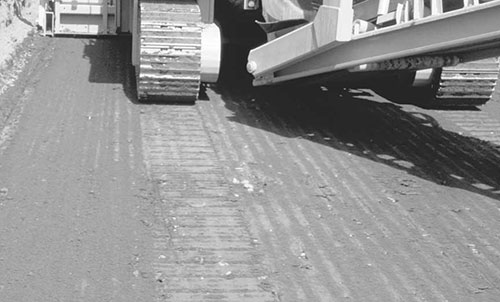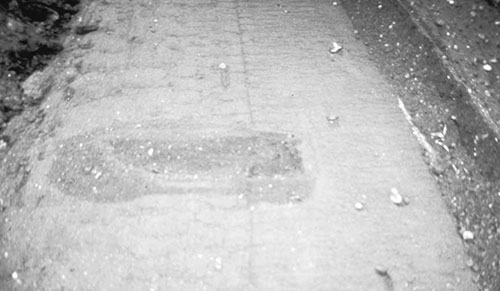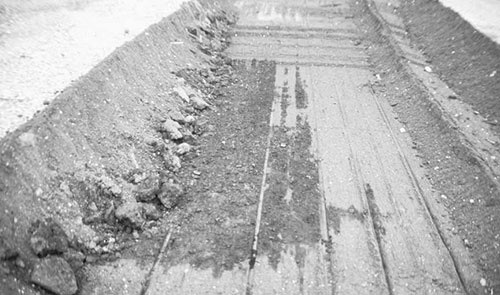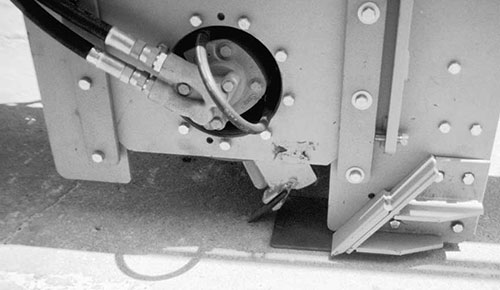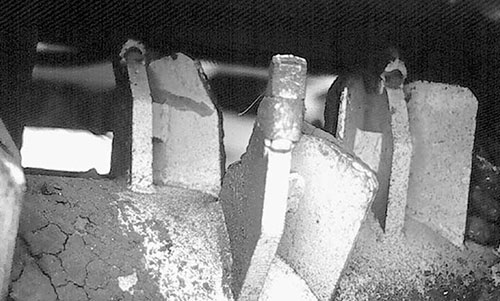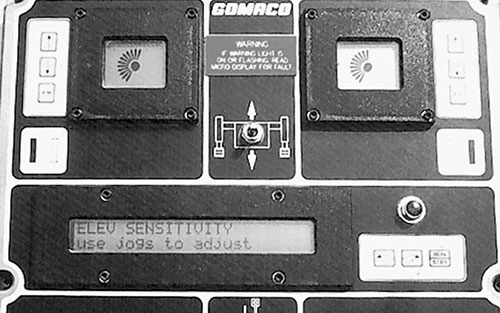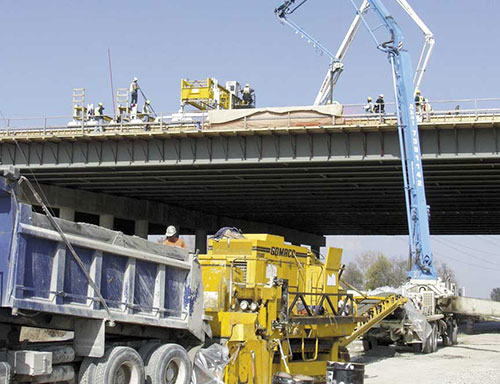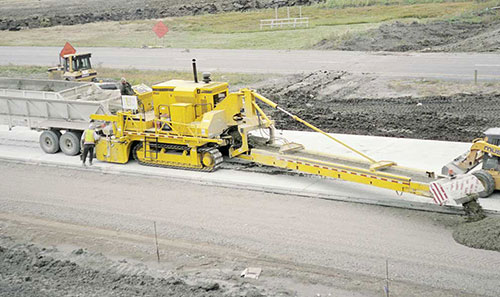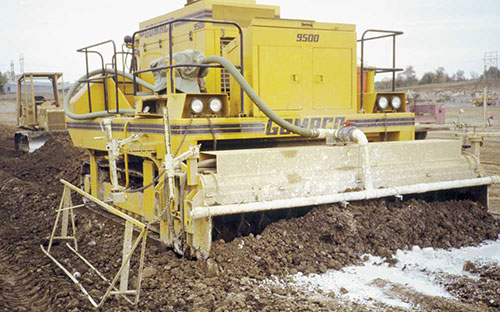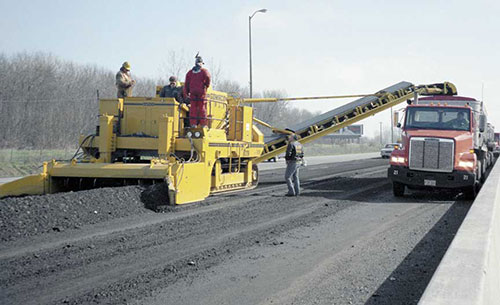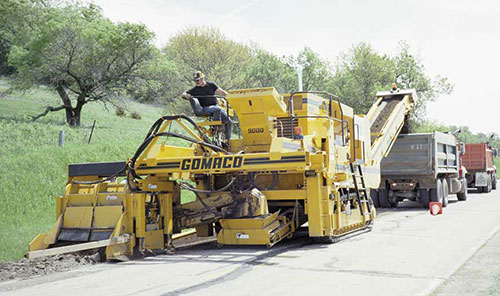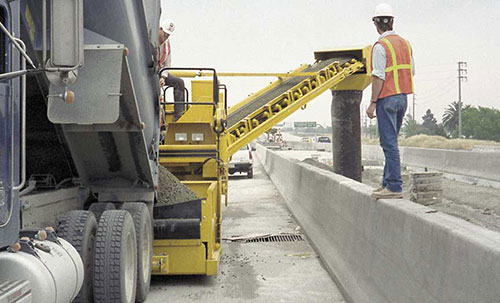GOMACO World Index --- GOMACO World 31.2 - October 2003
Accuracy and Versatility of the GOMACO Trimmers
By Dennis Clausen, GOMACO University Director of Training
Cut an Accurate Grade
Accurate subgrade requires the proper settings and adjustments be made on the trimmer. One of the key items that must be adjusted properly is the relationship between the height of the trimmerwheel teeth and the moldboard.
When the trimmerwheel is adjusted properly, the tooth marks are slightly visible in the compacted subgrade behind the trimmer (tooth marks may not be visible in a loose subgrade such as sand) (Photo 1). If the teeth are set too low in relation to the moldboard, excessive fine material may be left on the grade (Photo 2). If the teeth are set higher than the moldboard, "chunks" of the subgrade material may be torn out of the grade (Photo 3). If the teeth are too high, it can also cause high tractive pressure, difficulty controlling the steering of the machine and problems maintaining precise grade control on the machine. In most cases, the teeth are set to operate .25 to .375 inch (6 to 10 mm) below the moldboard. One way to check for the proper adjustment is to simply observe the grade behind the trimmer. Another way is to place a 6 x 6 x .375 inch (150 x 150 x 10 mm) plate under each end of the moldboard (should be on hard surface). The teeth should just touch the surface that the machine is sitting on. If not, adjust the wheel up or down as necessary (Photo 4).
One item that affects the relationship between the height of the trimmer wheel and the moldboard is tooth wear. On earlier machines, the teeth were a hardened casting. This type of tooth would wear down over time, changing the relationship. How long it took for the teeth to wear down depended on the type of material being trimmed. Obviously teeth wear was a lot quicker in an abrasive material. As the teeth wore down, the trimmerwheel needed to be lowered to maintain the relationship. When the teeth wore down to the holder, they needed to be replaced (Photo 5). With new teeth, the trimmerwheel needed to be raised back up to maintain the relationship with the moldboard. If compensation for tooth wear was not made, a poorly finished subgrade resulted.
Today's machines feature a carbide-tipped tooth. These teeth do not wear as fast as the old style, therefore less adjustment is needed. If the carbide tip breaks off, the tooth must be replaced.
Another item that will affect the finished grade is the sensitivity setting of the elevation controls. If the sensitivity setting is not correct, it will cause deviations in the subgrade. If the sensitivity is set too low, it will cause gradual "swales" in the finished product. Loose stringline or too much spring tension on the sensor wands can also cause these "swales." However, if the line is loose, or the spring tension high, the "swales" will be between the grade stakes with the grade correct at each stake. If low sensitivity is causing the "swales," it will be random and will not necessarily follow the grade stake spacing. If the sensitivity is set too high, it will cause the machine to over react. Initial grade sensitivity setting for an Analog system is to turn the adjustment all the way clockwise and then back a quarter of a turn.
Initial grade sensitivity setting on a Micro system is 4 to 5 indicators showing. Initial grade sensitivity setting on a Network system is 12 to 15 indicators showing and the setting is number 12 to 15 on the G21 system (Photo 6). The initial slope sensitivity setting on any of the control systems is normally at maximum. Once trimming operations have begun, adjust the sensitivity setting as high as possible without the machine becoming over sensitive. The sensitivity can be also affected by machine travel speed, rear conveyor position and depth of cut. Adjust the sensitivity to give the best results.
Saves Time & Material
Normally a trimmer is used to cut the final subgrade in preparation for paving. However, it can be used for more.
Consider for example when open graded base material must be placed on the subgrade. Normally a motor grader makes several passes to cut the base prior to applying the base material. If the grade is not cut close enough with the motor grader, an excess of material is used (wasted).
For example, if an extra .5 inch (13 mm) of base material is used on a project that is 24 feet (7.32 m) wide and 2700 feet (823 m) in length, over 100 tons (90 Metric Ton) of additional material is required. If the blade is used to cut the base material to final grade, the excess is simply pushed off to the side and wasted.
Now consider the use of the trimmer. It is used to cut the grade to the exact elevation, normally in one pass, prior to the placing of the base material. After the base material is in place, the trimmer is used to cut the base material to exact grade, again in one pass. The open graded base is now at the correct thickness and elevation. The excess material can be windrowed or loaded into haul units to be saved for the next project.
The same example will hold true when paving. If the grade cut with the motor grader averages .5 inch (13 mm) low for the same dimensions as above, an extra 100 yd3 (76.5 m3) of concrete will be used (wasted). If the grade cut with the motor grader is consistently high, it will cause a thin slab which may have to be removed.
Versatility is the Name of the Game
Today's contractor wants more versatility in a machine. Therefore, the question comes up, "What can I do with a trimmer other than trim grade?" A placing attachment is available for the machine. This attachment is installed in place of the trimmerhead in just a few short hours. With the placing attachment installed, concrete can be delivered from the central mix plant in dump or mixer trucks and placed in front of the paver without the trucks being on the trimmed grade. The material is dumped into the hopper and is conveyed to the paver in a swift action. Using this procedure allows dowel bar baskets to be preset on the grade in front of the paver. The operator can control the "head" of concrete in front of the paver by controlling the rear placing conveyor.
A contractor in St. Louis, Missouri, uses his 9500 for more than just placing concrete in front of his pavers. Concrete is delivered to most of his jobs by dump truck from central mix, even hand pours. He runs the concrete through the 9500 and accurately places the material in the forms. He also dumps concrete into the 9500 and supplies it to his Commander III when pouring barrier/ parapet walls and even when pouring curb and gutter.
A contractor in California uses a trimmer to cut the grade for slab-on-grade house construction. The grade for the concrete slab the house is to be built on must be within specs. Another contractor said he could cut the grade quicker with a motor grader. A housing development needed grade cut for approximately 20 new homes. The contractor with the trimmer cut 10 and the contractor with the blade cut the other 10. The motor grader did indeed cut his 10 in less time. The inspectors then showed up to inspect the grade. All 10 done with the trimmer were within spec, while more than half of those done with the grader were out of spec and required more work.
Other contractors that pour a lot of monolithic curb, gutter and sidewalk needed a better way to cut the rough grade. They equipped their trimmer with a monolithic trimmerhead and cut the rough grade ahead of their Commander III to within one inch (25 mm).
Highways built in days of old were often only 20 to 22 feet (6.1 to 6.7 m) in width. Most of the highways built today are at least 24 feet (7.3 m) wide. To improve the safety of these older highways, many of them are widened. This is done by excavating along the side and widening the base slab. The entire roadway is then overlaid, resulting in a new, wider road. The excavation along the side is normally accomplished through the use of an excavator of some type. The grade accuracy is less than desirable, causing the waste of paving material. GOMACO manufactures a special trimming attachment for the front of the 9000 or the 9500 that allows trimming to a specified width and an exact grade. The normal trimmerhead is removed and the special "shoulder trimmer" is installed. This trimmerhead is side-mounted, therefore keeping both tracks of the machine on the existing slab. Elevation and steering are normally taken off the existing slab, providing for an accurate match. The excess material that is trimmed can be windrowed to the side for back fill, or it can be loaded into haul units to be transported off the job site.
Another contractor added a slurry spray bar to the front of his trimmerhead. He sprayed lime-stabilizing material on the grade as he was trimming and mixed the material into the base material. The material was conveyed to the rear of the machine where it was then spread and compacted.
So as you can see, with a little ingenuity, the GOMACO 9000 or 9500 can be used for more than just trimming.
Subscribe to Receive GOMACO World Magazine
